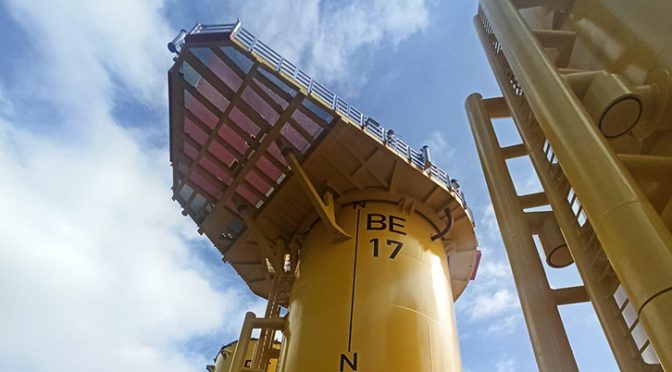- The manufacture of these parts will require 800 jobs and the participation of some 30 local suppliers.
- With a capacity of 476 MW, Baltic Eagle will supply 475,000 households with renewable energy.
The Iberdrola group continues to make progress in the construction of the Baltic Eagle offshore wind farm, the second major site of this technology that the company is developing in the Baltic Sea (Germany).
The project has reached a new milestone with Windar having completed 90% of the manufacturing work on the 50 transition parts of the wind farm, which will join the wind turbine towers to the foundations.
This work, which is being carried out at Windar’s facilities in Avilés, will involve 1.3 million hours of work, the equivalent of 800 jobs. Some 30 suppliers of the Asturian company in Spain are participating in the process, including steel production companies, components, equipment, testing and auxiliary machinery.
The production of these parts – each of which is 15 metres high, 6.5 metres in diameter and weighs 240 tonnes – will continue until the end of this year.
Windar will also be responsible for supplying the transition parts for the Vineyard Wind 1 offshore wind farm that Iberdrola is developing in the United States off the coast of Massachusetts, which, with 800 megawatts (MW) of power, will be the first commercial-scale facility of its kind in the country.
In addition, the Asturian company has manufactured the piles for the Saint-Brieuc wind farm (500 MW) – the Iberdrola group’s first large offshore wind farm in France – as part of the contract awarded to the Navantia-Windar consortium for the development of this project, which has created more than 1,000 direct jobs in Avilés and Fene.
These awards are in addition to the framework contract reached between Iberdrola and Navantia-Windar for the manufacture and supply of 130 XXL monopiles. In total, Iberdrola has so far awarded contracts worth more than €1 billion to this consortium, including the orders already completed for East Anglia One in the UK and Wikinger in the Baltic Sea.
The largest offshore wind power complex in the Baltic Sea
With a capacity of 476 MW, Baltic Eagle will have 50 wind turbines with a unit capacity of 9.53 MW on monopiles, for an annual production of 1.9 TWh, enough to sustainably meet the demand of 475,000 households and avoid the emission of almost one million tonnes of CO2 into the atmosphere each year.
Baltic Eagle represents the second major offshore wind initiative promoted by the Iberdrola group in Germany, following the commissioning of the Wikinger offshore wind farm (350 MW) at the end of 2017. The company is also developing another offshore facility in Germany: Windanker (300 MW). These three renewable facilities, located next to the island of Rügen, will give rise to the largest offshore wind complex in the Baltic Sea, with a total installed capacity of 1,100 MW and a combined investment of approximately 3.5 billion euros.
Baltic Eagle and Wikinger, with a combined capacity of 826 MW, will become the heart of the Baltic Sea Hub, a renewable hub in the Baltic Sea that will act as an epicentre for offshore and onshore wind services. They will be able to produce enough energy to cover 45% of Mecklenburg-Western Pomerania’s total electricity consumption and will save 1.65 million tonnes of CO2 per year.
Offshore wind power, key to Iberdrola's growth
Just as the Iberdrola group pioneered the development of onshore wind power more than two decades ago, the company is now leading the development of offshore wind power, one of the keys to the company’s growth, on which it began its commitment 15 years ago.
Thus, of the 7,000 MW of wind power currently under construction or secured with PPAs, more than 5,500 MW (78.5%) correspond to offshore projects. Iberdrola already has three large offshore complexes in operation: East Anglia ONE and West of Duddon Sands in the United Kingdom (more than 1,100 MW together) and Wikinger (350 MW) in Germany.
Iberdrola has a significant portfolio of projects in this technology focused on countries with ambitious decarbonisation targets. In the coming years, the company will invest around €30 billion worldwide with the aim of reaching 12,000 MW of offshore wind energy in operation by 2030.


